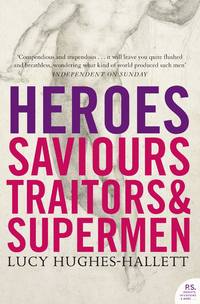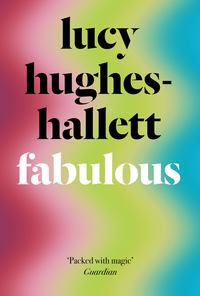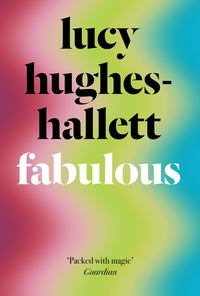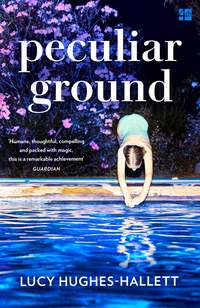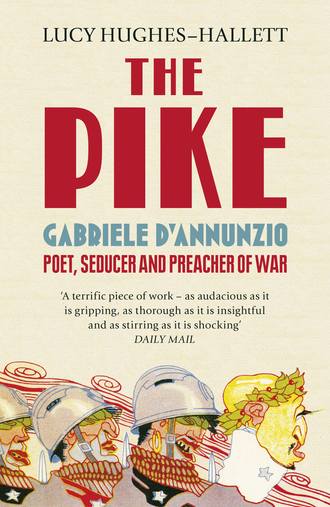
Полная версия
The Pike: Gabriele d’Annunzio, Poet, Seducer and Preacher of War

THE PIKE
Gabriele d’Annunzio
Poet, Seducer and Preacher of War
LUCY HUGHES-HALLETT

COPYRIGHT
4th Estate
An imprint of HarperCollinsPublishers
1 London Bridge Street
London SE1 9GF
www.4thEstate.co.uk
This ebook first published in Great Britain by 4th Estate in 2013
Copyright © Lucy Hughes-Hallett 2013
Map © John Gilkes
Cover shows d’Annunzio, 1919 (postcard, 14 x 9cm) by Ivo Tijardović (1895–1976)
The right of Lucy Hughes-Hallett to be identified as the author of this work has been asserted by her in accordance with the Copyright, Designs and Patents Act 1988
A catalogue record for this book is available from the British Library
All rights reserved under International and Pan-American Copyright Conventions. By payment of the required fees, you have been granted the non-exclusive, non-transferable right to access and read the text of this ebook on-screen. No part of this text may be reproduced, transmitted, down-loaded, decompiled, reverse engineered, or stored in or introduced into any information storage and retrieval system, in any form or by any means, whether electronic or mechanical, now known or hereinafter invented, without the express written permission of HarperCollins ebooks.
Source ISBN 9780007213955
Ebook Edition © March 2017 ISBN: 9780007356515
Version: 2017-03-17
PRAISE
From the reviews of The Pike:
‘A magnificent portrait of a preposterous character whose life is a scarcely credible saga of ambition and outrageous exploits … His biographer has done him full justice’ FRANCIS WHEEN, Mail on Sunday
‘A bland chronology is the opposite of Lucy Hughes-Hallett’s beautiful, strange and original structure. The Pike sets out the inner life of this fascinating man in a dazzling jumble of fragments and obsessions … An extraordinarily intimate portrait of him … we feel we are inside his life … If you want to understand fascism, you must start with d’Annunzio; and if you wish to understand him, then here is your book’ DANIEL SWIFT, New Statesman
‘Hugely enjoyable … Hughes-Hallett has a great talent for encapsulating an era or an attitude with an arresting one-liner … The fact that almost 700 pages flew by bears testimony to how pleasurable and readable those pages were’ TOBIAS JONES, Sunday Times
‘A deeply evocative new biography … She is a strong match for her subject, something that so many of the women in d’Annunzio’s life were lamentably not. Her style is rich, ironic and pugnacious; she jousts willingly with him and the reader becomes a spectator of this subtle and fascinating contest’ Economist
‘Hughes-Hallett dances her way through this extraordinary life in a style that is playful, punchy and generally pleasing’ IAN BIRRELL, Observer
‘It takes courage to write a biography like this one … its exhilarating virtuosity [is] d’Annunzian in the best sense’ JONATHAN KEATES, Sunday Telegraph
‘Engrossing and superbly written … Lucy Hughes-Hallett has written an eminently readable biography. Its strength lies in her ability to tease out and examine the strands of D’Annunzio’s complex personality in ways that continually illuminate how creativity can coexist with inhumane thought and action’ CHRISTOPHER DUGGAN, Times Literary Supplement
‘Exceptional … Hughes-Hallett has done an admirable job’ STUART KELLY, Scotsman
‘A vivid picture of the flow of ideas and inspirations in d’Annunzio, the meshing of work and character. The whole is an enthralling curiosity, much like d’Annunzio’s final epic monument to himself, the Vittoriale villa above Lake Garda’ ROBERT GORDON, Literary Review
‘[A] richly kaleidoscopic biography … In this scintillating study, full of wit and irony, she plumbs the depths of D’Annunzio’s horrible fascination’ PIERS BRENDON, The Oldie
for Lettice and Mary, with love
Contents
COVER
TITLE PAGE
COPYRIGHT
PRAISE
DEDICATION
I - ECCE HOMO
THE PIKE
SIGHTINGS
SIX MONTHS
II - STREAMS
WORSHIP
GLORY
LIEBESTOD
HOMELAND
YOUTH
NOBILITY
BEAUTY
ELITISM
MARTYRDOM
SICKNESS
THE SEA
DECADENCE
BLOOD
FAME
SUPERMAN
VIRILITY
ELOQUENCE
CRUELTY
LIFE
DRAMA
SCENES FROM A LIFE
SPEED
KALEIDOSCOPE
THE DOGS OF WAR
III - WAR AND PEACE
WAR
PEACE
THE CITY OF THE HOLOCAUST
THE FIFTH SEASON
CLAUSURA
SELECT BIBLIOGRAPHY
INDEX
ACKNOWLEDGEMENTS
NOTES
READ ON…
ALSO BY LUCY HUGHES-HALLETT
PICTURE CREDITS
ABOUT THE AUTHOR
ABOUT THE PUBLISHER
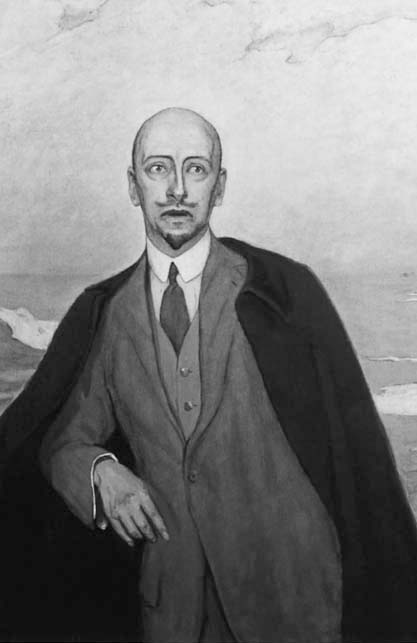
D’Annunzio – a portrait painted in 1910 by his lover, Romaine Brooks
I
ECCE HOMO
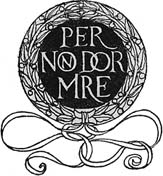
THE PIKE
IN SEPTEMBER 1919, Gabriele d’Annunzio – poet, aviator, nationalist demagogue, war hero – assumed the leadership of 186 mutineers from the Italian army. Driving in a bright red Fiat so full of flowers that one observer mistook it for a hearse (d’Annunzio adored flowers), he led them in a march on the harbour city of Fiume in Croatia, part of the defunct Austro-Hungarian Empire over whose dismemberment the victorious Allied leaders were deliberating in Paris. An army representing the Allies lay across the route. Its orders from the Allied high command were clear: to stop d’Annunzio, if necessary by shooting him dead. That army, though, was Italian, and a high proportion of its members sympathised with what d’Annunzio was doing. One after another its officers disregarded instructions. It was, d’Annunzio told a journalist later, almost comical the way the regular troops gave way, or deserted to follow in his train.
By the time he reached Fiume his following was some 2,000 strong. He was welcomed into the city by rapturous crowds who had been up all night waiting for him. An officer passing through the main square in the early hours of that morning saw it filled with women wearing evening dress and carrying guns, an image that nicely encapsulates the nature of the place – at once a phantasmagorical party and a battleground – during the fifteen months that d’Annunzio would hold Fiume as its Duce and dictator, in defiance of all the Allied powers.
Gabriele d’Annunzio was a man of vehement, but incoherent, political views. As the greatest Italian poet, in his own (and many others’) estimation, since Dante, he was il Vate, the national bard. He was a spokesman for the irredentist movement, whose enthusiasts wished to regain all those territories which had once been, or so they claimed, Italian, and which had been left irredenti (unredeemed) when Italians liberated themselves from foreign rulers in the previous century. His overt aim in coming to Fiume had been to make the place, which had a large Italian population, a part of Italy. Within days of his arrival it became evident this aim was unrealistic. Rather than admitting defeat, d’Annunzio enlarged his vision of what his little fiefdom might be. It was not just a patch of disputed territory. He announced that he was creating there a model city-state, one so politically innovative and so culturally brilliant that the whole drab, war-exhausted world would be dazzled by it. He called his Fiume a ‘searchlight radiant in the midst of an ocean of abjection’. It was a sacred fire whose sparks, flying on the wind, would set the world alight. It was the ‘City of the Holocaust’.
The place became a political laboratory. Socialists, anarchists, syndicalists, and some of those who had begun, earlier that year, to call themselves fascists, congregated there. Representatives of Sinn Féin and of nationalist groups from India and Egypt arrived, discreetly followed by British agents. Then there were the groups whose homeland was not of this earth: the Union of Free Spirits Tending Towards Perfection who met under a fig tree in the old town to talk about free love and the abolition of money, and YOGA, a kind of political-club-cum-street-gang described by one of its members as ‘an Island of the Blest in the infinite sea of history’.
D’Annunzian Fiume was a Land of Cockaigne, an extra-legitimate space where normal rules didn’t apply. It was also a land of cocaine (fashionably carried in a little gold box in the waistcoat pocket). Deserters and adrenalin-starved war veterans alike sought a refuge there from the dreariness of economic depression and the tedium of peace. Drug dealers and prostitutes followed them into the city: one visitor reported he had never known sex so cheap. So did aristocratic dilettantes, runaway teenagers, poets and poetry lovers from all over the Western world. Fiume in 1919 was as magnetic to an international confraternity of discontented idealists as San Francisco’s Haight-Ashbury would be in 1968; but, unlike the hippies, d’Annunzio’s followers intended to make war as well as love. They formed a combustible mix. Every foreign office in Europe posted agents in Fiume, anxiously watching what d’Annunzio was up to. Journalists crammed the hotels.
D’Annunzio was already a bestselling novelist, a revered poet, and a dramatist whose premieres were attended by royalty and triggered riots. Now he boasted that in Fiume he was making an artwork whose materials were human lives. Fiume’s public life was a nonstop street-theatre performance. One observer likened life in the city to an endless fourteenth of July: ‘Songs, dances, rockets, fireworks, speeches. Eloquence! Eloquence! Eloquence!’
By the time his occupation of Fiume came to an end, d’Annunzio’s dream of an ideal society had deteriorated into a nightmare of ethnic conflict and ritualised violence. For over a year it suited none of the great powers to bestir themselves to eject him, but when, eventually, an Italian warship arrived in the harbour and bombarded his headquarters, he capitulated after a five-day fight. But for the duration of his command, Fiume was – precisely as he had intended it should be – the stage for an extraordinary real-life drama with a cast of thousands and a worldwide audience, one in which some of the darkest themes of the next half-century’s history were announced.

D’Annunzio believed he was working to create a new and better world order, a ‘politics of poetry’. So did observers from every point on the political spectrum, from the conservative nationalists who eagerly volunteered to join his Legion, to Vladimir Ilyich Lenin, who sent him a pot of caviar and called him the ‘only revolutionary in Europe’. His followers saw Fiume as a place where life could begin afresh – rinsed clean of all impurities, freer and more beautiful than ever before. But the culture created there rapidly took on a character which, seen in retrospect, is hideous. Black uniforms decorated with lightning flashes which made malign supermen of their wearers; military spectacles staged as though they were sacred rites; a cult of youth which degenerated into licensed delinquency; the bullying of ethnic minorities; the never-ending sequence of processions and festivals designed to glorify an adored leader: all of these phenomena are now recognisable as typical of the politics, not of poetry but of brute power. Later, Benito Mussolini encouraged the writing of a biography of d’Annunzio entitled The John the Baptist of Fascism. D’Annunzio, who saw the fascist leader as a vulgar imitator of himself, was not happy with the suggestion that he was a mere harbinger, preparing the way for Mussolini’s Messiah. But though d’Annunzio was not a fascist, fascism was d’Annunzian. The black shirts, the straight-armed salute, the songs and war cries, the glorification of virility and youth and patria and blood sacrifice, were all present in Fiume three years before Mussolini’s March on Rome.
A great deal has been written about the economic, political and military circumstances in which fascism and its associated political creeds flourished. D’Annunzio’s story provides a lens through which to examine those movements from another angle, to identify their cultural antecedents, and the psychological and emotional needs to which they pandered. To watch d’Annunzio’s trajectory from neo-Romantic young poet to instigator of a radical right-wing revolt against democratic authority is to recognise that fascism was not the freakish product of an exceptional historical moment, but something which grew organically out of long-established trends in European intellectual and social life.
Some of those trends were apparently unexceptionable. D’Annunzio was a man of broad and deep culture, thoughtful, widely read in the classics and in modern literature. He spoke for Beauty, for Life, for Love, for the Imagination (his capitals) – all of which sound like good things. Yet he helped to drag Italy into an unnecessary war, not because he believed it would bring any advantage but because he craved cataclysmic violence. His adventure in Fiume fatally destabilised Italy’s democracy, and opened the way for all the bombast and thuggery of fascism. He prided himself on his gift for ‘attention’, for fully experiencing and celebrating life’s abundance. ‘I am like the fisherman who walks barefoot over a beach uncovered at ebb tide, and who stoops, again and again, to identify and gather up whatever he feels moving under the soles of his feet.’ He posed as a new St Francis, lover of all living things. Yet his wartime rants are, in every sense, hateful. Italy’s enemies are filthy. He ascribes grotesque crimes to them. He calls out for their blood.
‘His gift for pleasing is diabolical,’ wrote Filippo Tommaso Marinetti. Even people who heartily disapproved of d’Annunzio found him irresistible. Similarly, reprehensible though the Europe-wide fascist movements were (and are), history demonstrates the potency of their glamour. To guard against their recurrence we need not just to be aware of their viciousness, but also to understand their power to seduce. D’Annunzio was never as supportive of fascism as Mussolini liked to make out. He jeered at the future Duce as a cowardly windbag. He despised Hitler too. But it is certainly true that his occupation of Fiume drastically undermined the authority of Italy’s democratic government, and so indirectly enabled Mussolini’s seizure of power three years later; that both Mussolini and Hitler learned a great deal from d’Annunzio; and that an account of d’Annunzio’s life and thought amounts to a history of the cultural elements that eventually came together, in the two decades following d’Annunzio’s annexation of his City of the Holocaust, to ignite a greater and more terrible holocaust than any he had ever envisaged.
The poet was fifty-six years old when he set out for Fiume, as notorious for his debts and duels and scandalous love affairs as he was celebrated for his wartime exploits and his literary gifts. A plane crash had left him blind in one eye, and, as he embarked on his great adventure, he was so weakened by an alarmingly high temperature that he could barely stand (something not to be taken lightly during a period when some fifty million people died of Spanish flu).
Small, bald, with narrow sloping shoulders and, according to his devoted secretary, ‘terrible teeth’, he was unimpressive to look at, but the long tally of his lovers included the ethereally lovely Eleonora Duse, one of the two greatest actresses in Europe (Sarah Bernhardt was her only rival), and he could manipulate a crowd as easily as he could entice a woman.
Poets nowadays are of interest only to a minority. But d’Annunzio was a poet, novelist and playwright at a time when a writer could attract a mass following, and deploy significant political influence. On the opening night of his play Più Che l’Amore (More Than Love) there were calls for his arrest. After the premiere of La Nave (The Ship) the audience spilled out of the theatre and processed through the streets of Rome intoning a line from the play, a call to arms. When he gave readings, agents of foreign powers attended, fearful of his influence. When he wrote polemical poems, Italy’s leading newspaper cleared the front page and published them in full.
Italy was a new nation. Its southern half (the Bourbon Kingdom of the Two Sicilies) was annexed to the northern kingdom of Piedmont two and a half years before d’Annunzio’s birth. He was seven years old in 1870 when the French withdrew from Rome and the new country was complete. The heroes of the Risorgimento had made Italy. Now someone had to ‘make Italians’ (the phrase recurs in the political rhetoric of the period). D’Annunzio, after spending much of his twenties writing erotic lyrics in archaic verse-forms and Frenchified fiction, accepted the task. Goethe in Germany and Pushkin in Russia had been celebrated, not just as authors of fine literature, but as the creators of a new national culture. So would d’Annunzio be. ‘The voice of my race speaks through me,’ he claimed.
He was much admired by his peers. In his twenties he was one of the acknowledged leaders of the aesthetes. As he matured he wrote works which won admiration not only from his own generation, but also from his younger contemporaries. James Joyce called d’Annunzio the only European writer after Flaubert (and before Joyce himself) to carry the novel into new territory, and ranked him with Kipling and Tolstoy as the three ‘most naturally talented writers’ to appear in the nineteenth century. Proust declared himself ‘ravi’ by one of his novels. Henry James praised the ‘extraordinary range and fineness’ of his artistic intelligence.
But though he was an author first and foremost, d’Annunzio was never solely a man of letters. He wanted his words to spark uprisings and set nations ablaze. His most famous wartime exploits were those occasions when he flew over Trieste or Vienna, dropping not bombs (although he dropped those too), but pamphlets. For d’Annunzio, writing was a martial art.
He was a brilliant self-publicist. He associated himself with Garibaldi, the romantic hero of the Risorgimento, whose image – poncho, red shirt, the dash of the guerrilla fighter combined with the integrity of a secular saint – was as important to the cause of Italian unity as his military prowess. D’Annunzio borrowed the lustre of figures from the past: he also identified himself with the dynamism of the future. He had himself photographed alongside torpedo boats and aeroplanes and motor cars – sleek, trim and modern from his gleaming bald pate to the toes of his patent-leather boots. Looking back, in his years of retirement, he saw exactly what had been his greatest strength as a politician. ‘I knew how to give my action the lasting power of the symbol.’ The hero of his first novel learns that: ‘One must make one’s life as one makes a work of art.’ D’Annunzio himself worked ceaselessly on the marvellous artefact that was his own existence.
He made canny use of the brand new mass media. As a young man he was a prolific hack, pouring out reviews and gossip and fashion notes and quasi-autobiographical sketches. His more earnest-minded friends thought he was debasing himself, but he wrote that the seed of an idea, sown in a journal, would germinate and bear fruit in the public consciousness more quickly and surely than one planted in a book. He describes one of his fictional alter egos as being drawn to his public as a predator is drawn to its prey.
Reaching a mass audience, d’Annunzio became a new kind of public figure. The first television broadcasts were made only in the last years of his life, but his influence was akin to that of a modern mass-media pundit. Instead of looking up the social scale and the political hierarchy, seeking endorsement from the ruling class, he looked to the people, turning popularity into power. As the historian Emilio Gentile has put it, what fascism took from Fiume was not a political creed but ‘a way of doing politics’. That way has since become almost universal.
In December 1919, d’Annunzio called for a referendum in Fiume. The people were to decide whether he was to stay and rule them, or to be expelled from the city. He waited for the result of the vote sitting in a dimly lit restaurant, sipping cherry brandy with his supporters. He told them about a life-size wax effigy of himself that, so he claimed, was in a Parisian museum. Once his present adventure was concluded, he said, he would ask to be given the figure and seat it by the window of his house in Venice, so that gondoliers could point it out to tourists. He was aware that someone like himself had two existences, one as a private person, the other as a public image. He knew that his celebrity could be used – to amuse trippers, to make himself some cash, to boost an army’s morale, perhaps even to overthrow a government.
D’Annunzio’s story is worth telling for reasons beyond his great talent and his life’s drama, lurid and eventful though it is. It illustrates a strand of cultural history which has its apparently innocuous origins in the classical past, passes through the marvels of the Renaissance and the idealism of early nineteenth-century Romanticism, but which leads eventually to the jackboot and the manganello, the fascist club.
D’Annunzio read voraciously in several languages. He was adept at reviving neglected ideas whose time had come round again and he could spot a developing trend at the very moment of its formation. It is hard to find a cultural fad of the late nineteenth or early twentieth century which was not explored in his work. His flair for sensing what was new and influential moved Romain Rolland (a friend who became an enemy) to liken him to a pike, a predator lurking ‘afloat and still, waiting for ideas’. He was repeatedly accused of plagiarism, with some justice. He was a brilliant pasticheur, adopting and adapting the techniques of each new writer whose work impressed him. He wrote like Verga, he wrote like Flaubert, he wrote like Dostoevsky. But more intelligent critics noticed that he didn’t imitate so much as appropriate. When he saw something that could nourish his intellect drifting by on the current, he would snap at it, pike-like, and swallow it, and send it forth again better expressed.
He borrowed, but he also anticipated. Before Freud, he was fully aware of the nature of the excitement he derived from sleek machinery: the prow of a metal warship, he wrote, is ‘a monstrous phallic elongation’. Reading Nietzsche in the 1890s he recognised ideas already implicit in his own work. He had been modelling his verse on that of pre-Renaissance poets for a quarter of a century by the time Ezra Pound began to imitate the troubadours. He was writing about priapic fauns and pre-pagan ceremonies three decades before Nijinsky and Stravinsky sparked off a riot with The Rite of Spring. In 1888, a full two decades before Marinetti proclaimed a ruthless new machine-age aesthetic in the ‘Futurist Manifesto’, d’Annunzio wrote an ode to a torpedo. He loved motor cars and telephones and aeroplanes and machine guns. Marinetti’s manifesto is full of unacknowledged d’Annunzian sentiments, including the notion that civil society was so foul that only war could cleanse it.




